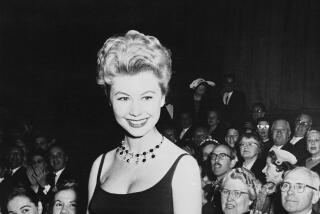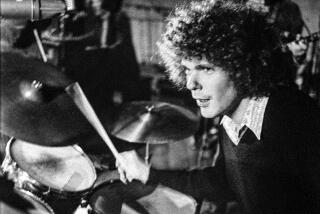Judy Garland’s ‘Day-by-Day’ Legacy
- Share via
June 10, 1922, 5:30 a.m.: Judy was born as Frances Ethel Gumm, in Grand Rapids, Minnesota. Frances was delivered by Dr. H.E. Binet of Grand Rapids, at Itasca Hospital. Weight at birth was 7 pounds.
--”Judy Garland: The Day-by-Day Chronicle of a Legend” by Scott Schechter
*
Judy Garland archivist Scott Schechter has a stack of the “greatest rejection letters I have ever seen” regarding his exhaustively researched--as the excerpted item above indicates--438-page book “Judy Garland: The Day-by-Day Chronicle of a Legend” (Cooper Square Press, $26.95), which arrives in stores today on what would have been Garland’s 80th birthday.
“They loved the book, but they didn’t know what to do with it,” Schechter says. “It was such a massive tome. It’s not a straight bio. It was really hard for publishers to pigeonhole it.” Last summer, though, his agent hooked him up with the editorial director of Cooper Square Press who agreed to publish it.
The book chronicles nearly every day of Garland’s life from her days as queen of the MGM musicals, her battles with drugs and alcohol, failed marriages, her children, her financial problems, comebacks and her death in 1969 at age 47. It also includes her last will and testament and even who was listed in her final phone book.
Entries range from the mundane: “On October 21: A check was issued to: Mel Burns Ford, 2000 Long Beach, Calif., for $163.88 (payment for Judy’s cars)” to the dramatic: “May 28, 1964: ... Judy took an overdose of pills ... Judy’s stomach was pumped--damaging her vocal cords with the tubes--and she was in a coma for 15 hours. At one point a valve actually broke on her oxygen tent, until it was fixed, Judy hadn’t moved; therefore, a nurse left the room saying Judy had died....”
Schechter jokes that he converted to “Judyism” in 1974 at the age of 13 when he went to see the acclaimed documentary on MGM musicals “That’s Entertainment” that featured clips of such Garland classic films as “The Wizard of Oz,” “The Harvey Girls,” “Meet Me in St. Louis” and “Summer Stock.”
“Someone also gave me a copy of the album of ‘Judy at Carnegie Hall,’ and one of the local stations in Philadelphia, where I am from, showed one of her concert TV shows,” Schechter says. “There was another local station that bought a package of MGM musicals, and my mom would actually let me stay home from school on the afternoons when there was a Judy movie.”
Schechter didn’t have any idea at the age of 13 that Garland would become his life’s work. “But it was love at first sight and first hearing,” he says. “There is something about her soul I had never experienced with any other performer. Judy just ripped her heart open and said, ‘Here it is.’ ”
As early as 1975, Schechter started working on his book. “I started transcribing what she would say about herself from interviews, and it grew from there,” he says. “With my move to New York in 1985, I started obviously using the great resources they have here--all the libraries. I think by 1987 I had a rough draft that was evolving more into an in-depth study about how she lived her life and what her life meant.”
A lot of the information featured in the book came from the Arthur Freed archives at UCLA. Freed was the top musical producer at MGM and Garland made most of her films for his production unit. “They had the assistant director’s daily logs, and of course, on a movie set, time is money, and every moment was recorded.”
He didn’t put in every moment of Garland’s life on the set or the book would have run over a 1,000 pages, but he did extensively chronicle her ill-fated experience on “Annie Get Your Gun,” from which she was fired in 1950 due to her personal problems.
“She was pretty much there on set,” Schechter says. “People have this impression of her never showing up for work. Even at the end of her life she had these huge concert shows and TV shows. She did not stop. She didn’t take vacation. This is a woman who lived to share her gift, her artistry.”
Schechter maintains everybody spends far too much time chronicling what was wrong in Garland’s life when “there was so much that went right. She has this massive body of work with 50 films, 60 TV shows and easily 1,500 live performances and 100 single recordings and a dozen albums. You don’t get to have that body of work if you are just living to marry or check in the hospital. I think Judy Garland coped awfully well with her life given what she had to deal with from Day One.”
Her mother, he says, was probably the worst stage mother on record. “She was just truly horrific,” Schechter says. “And to be a property at the age of 13 when you are signed to do this huge studio and by the time you are 17 you become a major star with ‘The Wizard of Oz.’ I can’t imagine what that felt like. She was seen as a property first and a person second.”
Contrary to some views of her, Schechter believes Garland was not a weak person who constantly wilted under pressure. “She was incredibly strong and incredibly bright. That is the only way she could have gotten through and achieved what she did.”
More to Read
Sign up for our Book Club newsletter
Get the latest news, events and more from the Los Angeles Times Book Club, and help us get L.A. reading and talking.
You may occasionally receive promotional content from the Los Angeles Times.










